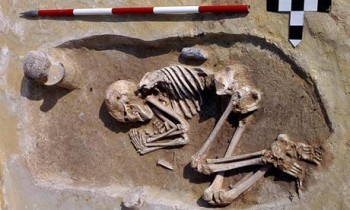Counter Culture is a 2 year project funded by the Arts and Humanities Research Council (AHRC). Through examining diversity in the lifeways of the earliest farmers in Europe, the project aims to reconsider the history of social inequality in
This blog is intended to make the progress of the project accessible to a non-academic and archaeological audience, but also to debate how we think about and model inequality in the past, impacts on how we think modern inequality operates and impacts on societies now. It has often been assumed that we see the first types of modern inequality among early farmers, through the start of property ownership. It seems at first glance a reasonable assumption, becuase it is the first time people start to own fields and animals. Or is it? Does ownership automatically lead to have's and have not's? The project aims to test the assumption that hierarchy and inequality are the inevitable consequences of farming.

For the first blog, we thought you might be interested to know some of the background to the project. Two pieces of previous research by the project team inspired the project. The first was a project that ran from 2008 to 2012 and analysed isotopic data across central Europe, to examine the lifeways of Neolithic farmers. The strontium isotope data, which tells us about lifetime mobility, demonstrated that women moved more than men and that some men had a very restricted strontium isotope ratio, suggesting that they did not move between birth and death. These men were buried with a particular item of material culture - a polished stone tool as you can see behind the back of the individual young male in the photo of a burial from Keinhadersdorf (Austria, Photo: Neugebauer/BDA). This was surprising. As the strontium values comes from teeth, and therefore from childhood, it meant that circumstances in childhood were influencing how people were buried when they died in adulthood. This was a surprise. Before this research, we thought the evidence pointed to ascribed status (that is, social identity was gained and changed through life). Our results, however, seemed to suggest some forms of identity, that impacted on how people were being buried at death, were there in childhood. In otherwords, we were beginning to see how kinship and inheritance were operating in this early farming society. Whether this means there was hierarchy, inequality or strict gendered patterns of behaviour is still uncertain and asnwering those questions will involve examining andn integrating a broad range of evidence. However, this project did give us the first glimpse that these techniques can help us to understand social life in more detail. You can read more about this project through our paper in the Proceedings of the National Academy of Sciences (PNAS) Community differentiation and kinship among Europe's first farmers You can also read about the project's results in this article by Maev Kennedy for the Guardian.
The second project which has inspired us was the Times of Their Lives project, which applied ground breaking mathematical techniques to refine radiocarbon dates. This method allowed the project to produce high resolution chronologies in prehistory. For archaeologists, this technique has been truely revolutionary. We have gone from talking about change over centuries to understanding how changes played out at the scale of the human lifetime or generation (which we estimate to be about 25-30 years), if not down to decades. Part of the project, examined the sequence between the 6th and 5th millennium BC in Alsace, and produced two surprises. First, there was a gap of about a century between the end of the early Neolithic Linearbandkeramik and the start of the Middle Neolithic occupation of the region. Second, a culture, the Grossgartach, which we thought lasted 250-300 years was shown to only last up 120 years. This really does change how we think about also sorts of elements relating to cultural change and social organisation during the Neolithic. Importantly, we can no longer argue for gradual change and unbroken populations. This opens up the possibility that forms of social organisation, hierarchies and inequalities changed dramatically across the Neolithic. You can read about the results of this project in more detail in our paper from 2017: The Cultural Project: Formal Chronological Modelling of the Early and Middle Neolithic Sequence in Lower Alsace
However, there remain gaps in both our knowledge and our ability to understand inequality in the Neolithic. Most of the exisiting models for forms of social organisation in prehistory are concerned with what happens at the top of the hierarchy. A good example of this is how frequently the narrative of Big Men becoming more entrenched politically or economically to become leaders of bigger groups is invoked to explain change. We think this is problematic because the agency for social changed is only applied to those people in the past who were elites or leading society. What happened to everyone else (and their contribution) has played more muted roles in our explainations for social change. We were also inspired by work on the role of inequality in modern societies by Prof. Kate Pickett (University of York). In their book The Spirit Level, Kate and Richard Wilkinson demonstrate that the more unequal a society the worse off everyone in the society is. While we do not expect Neolithic socieites to behave like modern ones, it did start us thinking about the diversity of prehistoric societies, and whether that had played a role in the changes we see across the Neolithic. Thanks to bioarchaeology we can explore the lifeways of everyone who was buried and has been preserved, irrespective of whether they were buried with elaborate grave goods or not. We can begin to tie that to the high resolution chronology to have a much more refined understanding of human diversity in the Neolithic.
So, its early days for the project, but come back soon for further updates as we get started with the analysis.
Penny







